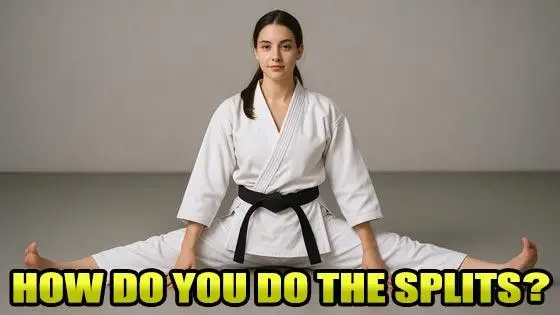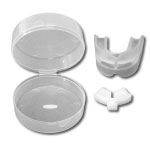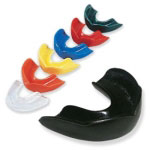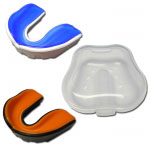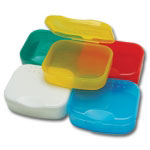Martial Arts & Karate Mouthguards for Sparring
-
$10.95
-
$5.54
-
$14.95
-
$6.95
A well-fitting martial arts mouth guard protects not only your teeth, but also helps keep your lips, tongue, and gums from getting torn up during contact drills. Even more importantly, it can reduce the risk of a concussion by cushioning the shock when your jaw takes a hit. That's why every serious athlete, whether they're throwing kicks in karate or trading jabs in a boxing ring, should be wearing one anytime there's contact above the shoulders.
We've got options for just about every training style and comfort level. Traditional boil-and-bite mouthguards are still a favorite because they're easy to mold and give you a custom fit without the custom price. For athletes who want more jaw stability, our double mouthguards offer protection for both the upper and lower teeth. These help keep your mouth aligned and your brain better protected during heavy sparring. If comfort is your top priority, check out our gel mouthguards. They have a softer interior layer that molds around your bite while still offering a tough outer shell for impact absorption.
Some fighters prefer a minimalist feel that lets them breathe easier during long rounds. Others want maximum security for full-contact drills. No matter your preference, we've got sparring mouthguards that strike the right balance between protection, fit, and performance. Most of our options come in multiple colors and styles, and we also carry mouthguard cases so you're not tossing a dirty guard straight into your gym bag after training.
If you're training in karate, a solid karate mouth guard is a must, especially during sparring sessions or tournaments where head contact is allowed. Many styles of karate, including full-contact variations like Kyokushin or knockdown tournaments, require mouth protection for safety and competition rules. But even if you're just doing light-contact point sparring, it only takes one stray punch or kick to do real damage. A properly fitted karate mouthguard can save you from expensive dental bills and painful injuries.
Mouthguards have been around longer than most people think. The earliest versions were used in boxing during the late 1800s, when fighters would stuff bits of cotton, wood, or even rubber between their teeth to protect themselves. They were crude but effective enough to start a trend. Over time, dental professionals got involved, and modern mouthguards evolved into what we know today. Durable, comfortable, and made to handle impact, these guards are now standard equipment for athletes in all kinds of sports. In martial arts, they've become essential.
If you're new to training, it's smart to start with a boil-and-bite model. You heat it up, bite down, and shape it to your teeth. It takes just a minute or two. These are popular because they're affordable and work well for beginners and experienced fighters alike. For more intense training, especially full-contact sparring, you might want to upgrade to a double mouthguard or a gel model that gives you extra shock absorption without sacrificing comfort. And don't forget the basics. A clean, dry mouthguard lasts a lot longer, so having a vented case to store it between uses is just good hygiene.
We know how hard martial artists train. You push yourself to get stronger, faster, and sharper every day. So don't leave your mouth unprotected while you're leveling up your skills. If you're serious about your training, you need to be serious about protecting your teeth, your jaw, and your brain. Train smart, spar safe, and don't skip the basics.
What's the difference between single and double mouthguards?
A single mouthguard covers only your upper teeth. It's the most common type used in martial arts and is popular because it allows for easier breathing and speaking during training. Single guards are typically molded to fit snugly around your upper teeth and gums, offering solid protection while staying lightweight and low-profile.
A double mouthguard covers both the upper and lower teeth at the same time. This design offers more complete jaw protection, especially during heavy contact or full-power sparring. It helps reduce the risk of jaw clenching and can minimize shock traveling from the chin to the skull. However, because it covers both arches, some fighters find it a little harder to breathe or talk with a double in place.
If you're doing light to moderate sparring, a single martial arts mouth guard is usually all you need. For full-contact training or competition where jaw protection is a top priority, a double mouthguard might be the better pick.
Do I really need a mouthguard for light-contact sparring?
Yes, absolutely. Even in light-contact sparring, accidents happen. A mistimed punch, a wild kick, or an unexpected clash of heads can cause serious damage if your mouth isn't protected. It doesn't take full power to chip a tooth or split a lip. In fact, most dental injuries in martial arts happen during what is supposed to be controlled practice.
A good sparring mouthguard acts like a shock absorber for your face. It cushions your teeth and gums from sudden impact and helps keep your jaw in place if you take a hit. Plus, once you're used to wearing one, it barely feels like it's there. If you're training with any kind of head contact, no matter how light, wearing a mouthguard should be part of your regular routine.
How do I mold a boil-and-bite mouthguard correctly?
Start by bringing a pot of water to a gentle boil. Once it's bubbling, remove it from the heat and let it sit for about 30 seconds so it's not scalding. Drop the mouthguard into the hot water and let it soak for 15 to 60 seconds, depending on the instructions for your specific model. It should be soft enough to shape but not melt.
Carefully remove the mouthguard with tongs, let it cool for just a second or two so it won't burn your mouth, then bite down firmly and evenly. Use your fingers to press the mouthguard against your front teeth and gums while sucking in slightly to create a tight seal. Hold that position for about 30 seconds.
After molding, place it in cold water to set the shape. If it doesn't fit quite right, you can usually reheat and try again. Just be sure not to overheat it the second time. Once it fits snugly without falling out or pinching, you're good to go.
Can kids use the same type of mouthguard as adults?
Not exactly. Kids should use youth-sized mouthguards that are made specifically for smaller mouths. An adult-sized mouthguard is usually too bulky for a child and won't mold properly, which can make it uncomfortable or even unsafe to wear during training.
Youth mouthguards are designed to be more flexible and easier to mold. They also come in fun colors, which can help younger martial artists actually want to wear them. If your child is losing baby teeth or has braces, look for a mouthguard that's labeled as orthodontic-safe or remoldable, so it can adapt as their mouth changes.
A properly fitted karate mouthguard or sparring mouth guard should stay in place without needing to be chewed or adjusted constantly. If it falls out or feels too loose, it's time to resize or replace it.
How often should I replace my mouthguard?
Most martial artists should replace their mouthguard every 6 to 12 months, depending on how often they train and how well the guard is holding up. If you're training several times a week or doing heavy sparring, you might need a new one sooner. Look for signs like thinning material, cracks, loose fit, or any rough spots that could irritate your mouth.
For kids and teens, replacements are needed more often since their teeth and jaws are still growing. A mouthguard that fit perfectly a few months ago might not offer full protection anymore if their bite has changed.
Also, if you've taken a hard shot to the face, always inspect the mouthguard afterward. Even one strong impact can warp the material or throw off the fit. When in doubt, it's safer to replace it than to risk an injury from a worn-out guard.
What's the best mouthguard for karate tournaments?
For karate tournaments, the best mouthguard is one that fits securely, allows you to breathe easily, and meets the rules of the organization you're competing in. Most point-based tournaments allow single mouthguards, and a well-molded boil-and-bite style is usually the top choice. It gives you a custom fit, stays in place during fast movements, and doesn't interfere with breathing or speaking.
If you're competing in a full-contact karate style like Kyokushin or another knockout-based format, you might want a thicker mouthguard or even a double model for extra jaw protection. Just make sure it doesn't restrict airflow, since those matches tend to be more intense.
Always check the competition rules ahead of time. Some organizations have specific requirements for color, material, or thickness.
Do gel mouthguards offer better protection than standard ones?
Gel mouthguards don't always offer more protection, but they do offer more comfort, and that can make a difference in how well you wear and use them. A gel mouthguard usually has a soft inner layer that molds easily around your teeth, combined with a firmer outer shell that absorbs impact. That dual-layer design helps it stay in place better and feel more natural, especially during long sparring sessions.
Standard boil-and-bite mouthguards can protect just as well if they fit properly, but they tend to be a bit firmer all the way through. Some fighters prefer that rigid feel, while others like the extra cushioning of gel. It really comes down to how intense your training is and what feels most secure in your mouth.
If you're doing moderate to heavy sparring, a gel model can give you more comfort without sacrificing safety. And the more comfortable your mouthguard is, the more likely you are to wear it every time you train.
Can a mouthguard actually help prevent concussions?
A mouthguard can't prevent a concussion entirely, but it can lower the risk. When you take a hit to the jaw, the force can travel up into your skull and cause your brain to shift inside your head. A well-fitted mouthguard acts like a shock absorber, softening that impact and helping to stabilize your jaw.
By reducing the amount of force that reaches the brain through the jaw, a mouthguard adds a layer of protection during contact drills and sparring. It doesn't replace headgear or eliminate all danger, but it's an important part of your overall safety gear.
If you're training in a striking art like karate, boxing, or MMA, wearing a mouthguard is one of the smartest and simplest ways to protect your head during impact.
How do I clean and store my mouthguard after training?
Right after training, rinse your mouthguard with cool water to get rid of sweat and debris. Then give it a quick scrub with a toothbrush and mild soap or toothpaste. Avoid hot water, since it can warp the shape and ruin the fit. Some people like to use mouthwash or a denture-cleaning tablet for a deeper clean once a week, which works well as long as you rinse it thoroughly afterward.
Let the mouthguard air dry completely before storing it. Throwing it into a closed container while it's still wet can lead to bacteria and mold buildup. Use a vented mouthguard case that keeps it protected but still allows airflow.
Never leave your mouthguard in a hot car or wash it in the dishwasher. High heat can distort the material and make it useless. With regular cleaning and proper storage, your guard will stay fresher, last longer, and stay safer to use.
Can I wear a mouthguard with braces or dental work?
Yes, but you need a mouthguard that's specifically designed for braces or dental appliances. Standard mouthguards can press too tightly against the brackets and wires, which could cause damage to your braces or even cut the inside of your lips. A braces-friendly mouthguard is made from softer, more flexible material and leaves room for the brackets while still protecting your teeth and gums.
If you have a permanent retainer, dental implant, or other specialized dental work, talk to your orthodontist or dentist before choosing a mouthguard. They may recommend a custom-fit version or give you tips on which styles are safe to use.
Never try to mold a boil-and-bite mouthguard directly over braces unless it's labeled as safe for that purpose. The heat and pressure can mess with the alignment and possibly pull at the brackets. The key is finding a mouthguard that cushions impact without interfering with your treatment.







